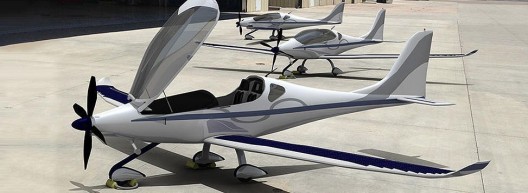Aero Electric Aircraft Corporation (AEAC) and Spartan College of Aeronautics and Technology made joint announcements about their signing a “Training Program Development and Deposit Agreement” for the school to reserve the first 20 delivery positions for “Sun Flyer” solar-electric training aircraft being developed by AEAC. This first such agreement by a major training program and an aircraft maker is a milestone for this new technology.
The press announcement quotes Peter Harris, CEO of Spartan College, saying, “This agreement signifies our commitment to innovation and to serving the next generation of pilots. Spartan College is honored to be the first training school to formalize our collaboration on a complete training system that will make flight training more modern, accessible and economical than ever before.”
The same announcement has George Bye, CEO of AEAC, thanking Spartan College for their collaboration and support. “Our goal with Sun Flyer is to achieve lower operating costs and enhanced safety features for a training airplane by focusing on the benefits of solar-electric propulsion and durable composite construction. Spartan College is to be commended for their innovative spirit and forward-thinking strategy.”
AEAC plans to offer “the first certified U.S.-sponsored, practical, all-electric airplane serving the aviation training markets.” George Bye and his team displayed the Sun Flyer at AirVenture 2014 in the RedBird tent, with the promise that flight schools will be able to take advantage of the flight simulator background of that company.
Four major electric aircraft developers, AEAC, Airbus, Pipistrel, and Yuneec (now GreenWings in California) have flown at least initial demonstrators of their electric aircraft, with Pipistrel fielding a two-seat WATTS-UP available. Airbus is now creating a plant outside Paris with partner Daher-Socata to build two- and four-seat versions of their E-Fan aircraft, while AEAC has partnered with Calin Gologan’s PC-Aero to make their training aircraft. (Note Added 1/17/2015: Calin Gologan explains that the Sun Flyer will be built and marketed in America, based on a license agreement between PC-Aero GmbH – the designer of the airplane – and Bye Aerospace. PC-Aero will build And sell the German ultralight version named the Elektra Two Trainer. Bye Aerospace will manufacture and market worldwide the FAA certified Version.)
Mary Grady, reporting in Wired, headlines that “Electric Airplanes Are the Future of Pilot Training.” She notes that current flight trainees are initiated in “an aging airplane that’s noisy, expensive, and burns leaded fuel.” She notes that the “race is on to change that, with electric trainers that are clean, vibration-free, and cheap to operate.”
She quotes George Bye, head of AEAC, as saying, “Electric airplanes will change everything when it comes to the cost of flying.” Her Wired article recites Bye’s math, which shows that a typical Cessna 172 has operating costs of about $73 per hour, and a new one sells for about $370,000. Bye’s Sun Flyer would sell for $180,000 to $200,000 and cost under $10 per hour for basic operating costs – including charging and battery replacement. This would allow flight schools to bring total per-hour rates down to levels where an average, middle-class pilot wannabe could afford flight training.
Bye hopes for certification of the two-seater by 2017, which may be coincide with Federal Aviation Administration approval of such aircraft. Currently The FAA is still considering such rules and prohibits carrying a passenger in an electric airplane. All the players will benefit from a favorable ruling in this matter, with all charging toward a 2017 or earlier introduction and initial sales date.
Mary includes the recently introduced Chinese two-seater, the RX-1E, which will probably have pricing and performance similar to the others in this group. Like the rest, its limited endurance won’t immediately be a problem for a student pilot who will spend most of his or her time in the circuit and making touch and goes.
She concludes with hopes for more: “If battery costs continue to decline and electric planes can spend more time in the air, it will grow harder to make the case for gasoline engines, at least for the training market, where flights are brief and you don’t need more than two seats. Besides the clear cost advantage, electric flight is just smoother and quieter, and maintaining an electric airplane is a lot less trouble, thanks to fewer moving parts. If learning to fly is on your to-do list, you might find the trainer planes of the not-too-distant future parked outside in the sun, powering up for your first lesson.”
She’s definitely sold on the idea. Now let’s hope the manufacturers can deliver on their promises.


Comments 1
Sunflyer will be built And marketed, based on a license agreement between PC-Aero GmbH the Designer of the airplane And Bye Aerospace. PC-Aero will build And sell the German ultralight version named Elektra Two Trainer. Bye Aerospace will manufacture and market worldwide the FAA certified Version.
Calin Gologan , CEO PC-Aero GmbH.
(Editor’s note: Thanks to Mr. Gologan for the clarification.)